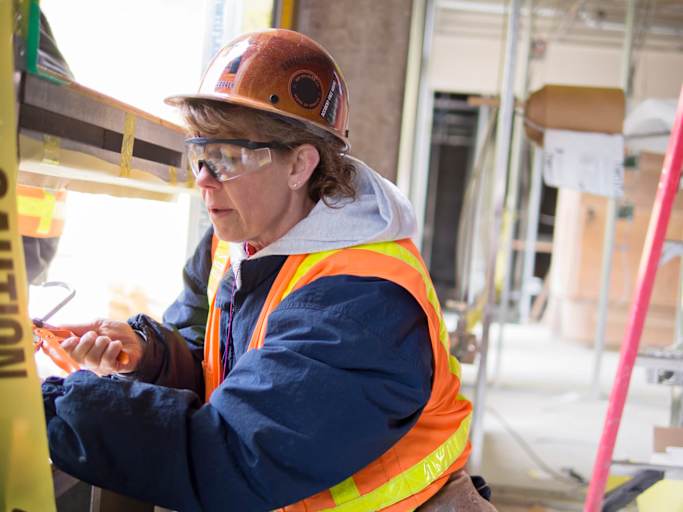A Guide for People of Color in Skilled Trades
- Skilled trades are in demand, with 321,000 construction job openings in July 2021.
- Trade schools and apprenticeships can help workers enter trade careers quickly.
- A diverse workforce drives business success and employee satisfaction.
- People of color can find support from trade schools, apprenticeships, and other organizations.
Companies across the United States continue to search for new workers. From healthcare to farming, every industry faces challenges in finding skilled workers. Hiring people of color in skilled trades offers companies the opportunity to not only fill open positions, but also build stronger, more successful organizations.
According to the U.S. Bureau of Labor Statistics (BLS), there were 10.9 million job openings at the end of July 2021, with most of those unfilled jobs in the healthcare and social assistance, finance and insurance, and accommodation and food service industries. Many of these jobs do not require a four-year degree, but employers do need workers with specific skills. For example, the construction industry had an estimated 321,000 job openings in July 2021.
Although they may not require a four-year degree, skilled trade jobs often require some form of postsecondary training or an associate degree. Most of these programs last two years or less. Many trade careers offer strong career growth and above-average salaries. As employers look to fill these in-demand skilled trade jobs, people of color interested in working in skilled trades should find more career opportunities.
However, some employers and industries struggle to hire diverse teams. People of color in skilled trades may find they make up a relatively small percentage of the workforce. And students entering trade school may find it challenging — especially if they do not see instructors, supervisors, or peers who share their identities. Trade schools, apprentice programs, and professional organizations often provide resources that can help students succeed in their training and their new careers.
What Are Skilled Trade Jobs?
Skilled trades require workers to understand specific processes and procedures for the job at hand. Many skilled trade jobs require hands-on work, like construction or plumbing. Skilled trades also include computer-related careers in technical support and legal assistant positions. Once filled by workers from the baby-boom generation, many of these roles are now open as older workers retire, and employers need skilled workers to take their place.
Skilled trade jobs do require training, often through a trade school or apprenticeship. Vocational school curricula emphasize learning by doing, with hands-on training throughout a program. Students often do not take general education courses, but focus entirely on their career field. Programs vary in length from a few months to 1-2 years.
Trade schools often charge students much lower tuition compared to four-year schools. According to CollegeBoard, in-state students attending public four-year colleges pay an average of $9,410 in tuition each year. In contrast, in-district students pay $3,440 per year at public two-year colleges. Many two-year colleges offer training in skilled trades. Additionally, apprenticeships often pay participants a wage while they learn the skills needed to succeed in their new field.
Why the Workforce Needs People of Color in Skilled Trades
Business experts have long known the value of diversity in the workforce. According to the nonprofit business mentoring organization SCORE, diverse teams bring more innovation to businesses, operate more efficiently, and drive worker satisfaction. In 2020, SCORE shared data showing businesses with more diverse management teams earned 19% more revenue and made decisions with half the number of meetings.
As companies struggle to fill open positions, potential workers are looking at the teams and businesses recruiting them. SCORE found 67% of job seekers cited a diverse workforce among factors they considered when evaluating a job offer, and 72% said they would consider leaving their organization for one they believed to be more inclusive.
However, people of color may find themselves underrepresented in a variety of skilled trades jobs. For example, according to a 2019 report from the BLS, only 6% of Black or African American individuals worked in natural resource, construction, and maintenance fields compared to 10% of white workers. People of color in skilled trades can find rewarding careers without taking on heavy student debt.
Skilled Trade Jobs
According to the BLS, as of 2017, electricians earned the highest wage among occupations requiring postsecondary training but not a degree. The BLS projects 9% growth in employment of electricians — or the creation of about 66,100 new jobs — between 2020 and 2030. Many electricians gain their skills through apprentice programs with paid on-the-job training. About 9% of electricians own their own business, though most work for electrical contractors.
Skilled trades encompass a variety of careers in many industries. The list below features just a few of the skilled trade jobs available.
Construction Trades
- Carpenter
- Contractor
- Electrician
- HVAC Technician
Motor Power Trades
- Automotive Technician
- Aviation/Aircraft Mechanic
- Diagnostic Technician
- Motorcycle Mechanic
Service Trades
- Chef
- Educational Assistant
- Hair Stylist
- Massage Therapist
Industrial Trades
- Dental Technician
- Diagnostic Technician
- Jeweler
- Medical Appliance Technician
Resources for People of Color in Skilled Trades
Starting a new career can feel daunting to students entering trade school or apprenticeships. Those feelings may be magnified for students who do not see mentors or instructors who look like themselves.
A 2021 review of research literature by the University of Victoria cited lack of role models, poor working conditions, and limited access to training and careers as challenges for students from underrepresented groups as they started their careers. The review also found women of color experienced higher rates of harassment in their workplaces or felt unsafe because of their gender and race.
There are many resources available to help people of color find success in skilled trades positions. The sections below highlight how trade schools, apprenticeships, and other organizations can help you complete your training and succeed professionally.
Trade School
Trade schools offer students a fast track to skilled trades that are in demand, featuring career-focused curricula and hands-on learning. Unlike four-year colleges, trade schools do not require general education classes like math, English, or history. Instead, students start working toward their new careers on day one.
You can find skilled trades training through public and private trade schools or community colleges. Many community colleges offer career training programs at a much lower cost than four-year colleges, and many programs can be completed in just one year.
Trade schools often provide student services like financial aid and career counseling. These services help students identify career opportunities and finance their education, helping reduce student debt after graduation. You can also seek out scholarships for students in vocational programs. And students who belong to underrepresented groups can take advantage of scholarships and grants specifically designed to help increase the participation of people of color in skilled trade careers.
Apprenticeships
Trade school isn’t the only path to landing a skilled trade job. Apprenticeships allow people to learn their trade while earning a paycheck. Apprentices gain relevant job experience and learn from people who have years of experience in their field. According to information shared by the U.S. Department of Labor, 94% of apprentices who complete their training continue working with their employer. These workers earn an average salary of $70,000.
Apprenticeships first began in the Middle Ages, with master artisans teaching their crafts to younger people. The practice continues today through registered apprentice programs. The United Association apprenticeship program dates back to 1936, training new plumbers, fitters, and welders. The five-year program combines classroom instruction with on-the-job training.
More industries have launched apprentice programs to help mitigate staffing needs. For example, IBM has launched a tech worker apprentice program, helping job seekers launch a new career without earning a four-year degree. Program requirements vary by industry, but many only require a high school diploma.
Organizations
Organizations support workers in skilled trade jobs through mentorship, advocacy, and education. These organizations can assist people of color in skilled trades by connecting them to professional networks, internships, and scholarship programs.
Black Girls Code, for example, has set a goal of training 1 million girls for careers in science, technology, engineering, and math fields by 2040. The organization connects youth with volunteer mentors and offers classes and workshops for girls from underrepresented communities. Black Girls Code chapters currently offer programs in 15 cities across the country.
The Conference of Minority Transportation Officials advocates for diversity and inclusion within the transportation industry. It seeks to remove employment barriers and maximize opportunities within the industry for individuals considered minorities in the field. The conference supports leadership development, funds scholarships and internships, and builds networking opportunities.
Government agencies also have programs and offices focused on supporting people of color in skilled trades. Check with your state or federal Office of Civil Rights for information on equal employment opportunities, programs for disadvantaged business enterprises, and on-the-job training programs. Additionally, the Department of Transportation Federal Highway Administration offers a summer internship program for students of diverse backgrounds interested in transportation careers.
Frequently Asked Questions About People of Color in Skilled Trades
According to the BLS, more than 100 occupations require skilled workers. Skilled trades that are currently in demand include tractor-trailer truck drivers and nursing assistants. The BLS projects 122,100 new jobs for truck drivers between 2020 and 2030, with about 231,000 job openings each year as workers leave the industry or retire. Truck drivers earned a median salary of $47,130 per year in May 2020. These drivers need a commercial driver’s license. Training, either through a trade school or a company program, requires 3-6 months to complete.
Yes, many skilled trades offer above-average salaries in stable and growing career fields. According to the BLS, U.S. workers earned a median salary of $41,950 in May 2020. Many trade careers meet or exceed this salary. Computer support specialists, for example, earned a median annual salary of $55,510 in May 2020.
Additionally, the BLS projects an overall job growth rate of 8% in the U.S. from 2020-2030, but many skilled trades are projected to exceed this average. For example, over that same period, the BLS projects 68% growth in the employment of wind turbine technicians and 52% growth for solar photovoltaic installers. These professionals earned median salaries of $56,230 and $46,470 per year in 2020, respectively.
Salaries vary widely depending on a worker’s employer, location, and experience. However, elevator and escalator installers reported a median pay of $88,540 per year, as of 2020 — one of the most lucrative positions among trade workers. Additionally, radiation therapists reported a median salary of $86,850. These medical professionals administer radiation treatments in hospitals, physician offices, and outpatient centers.
Explore More College Resources

A Guide to Trade School for Women
Trade school can lead to high-paying careers with little college debt. Read on to learn what trades for women are best for you.

by Beth Walton
Updated October 25, 2024



